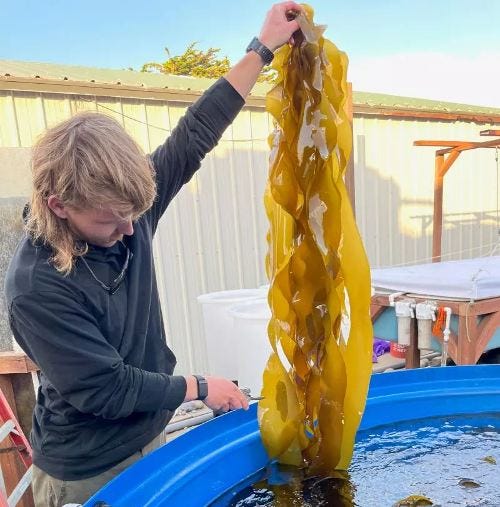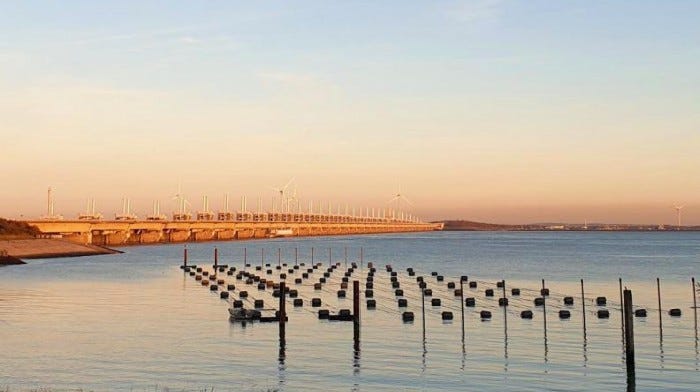New courses for ocean farmers in US and UK
Also: Seaflour to replace carrageenan, kelp forest restoration manual, Climate Foundation wins XPrize
A few weeks ago, Greenwave launched their Ocean Farming Hub, with resources for aspiring kelp and shellfish farmers to learn if and how they can start farming the ocean. It’s an impressive piece of work; besides the courses, I really like their interactive farm designer tool, and there is intelligent debate on the community forum.
A week later, the Seaweed Academy opened in Scotland. Without the online component, it offers a more hands-on, in-person curriculum for aspiring growers in the UK.
With more than 1000 registrations for Greenwave’s Hub so far, and hundreds more attending the Seaweed Academy launch, both initiatives look set to flourish. There is clearly a huge need for answers to the question: how do I start a small-scale seaweed farm?
It’s great to see the enthusiasm, despite the enormous hurdles: the years-long fight with regulators, the large up-front investments, the struggle to build a market. We will have to see if the enthusiasm stays up when the next critical question comes along in a few years: how do we make/keep small-scale ocean farming profitable? Is it actually possible to avoid the mistakes made in agriculture?
More thoughts on that next time, but Greenwave’s Kelp Climate Fund is perhaps a step in the right direction.

Seaflour to replace carrageenan
Food ingredients multinational IFF has unveiled Seaflour, a minimally processed “nutrient-dense hydrocolloid” from red seaweed to stabilize plant-based milks that can replace carrageenan, which consumers are increasingly suspicious of. Seaflour enables shorter ingredient lists, which should delight plant-based milk producers.
Seaflour competes with other carrageenan alternatives recently launched, including Cargill’s WavePure and Algaia’s range of alginates.
Seaweed snacks moving into retail
Snacks from UK’s Seaweed Agogo will soon be on the shelves of Lulu, the Middle East’s biggest retail chain, while Seamore has added a 5th country to distribute its sea chips with a listing in Selfridges in London. However, as Seamore admits, the problem is not getting on shelves, it’s getting bought off it - no easy feat for small brands who cannot afford the in-store promotions and prime placements.
That’s less of a problem for VC-backed Bettafish, pumping out new product and partnership announcements every few weeks. Latest: new Tu-Nah spreads available across Austria.
Investments
The Seaweed Company acquired Zeewaar, The Netherlands’ pioneering seaweed farm, expanding their footprint in Europe beyond their operations in Ireland.
Mining company De Beers invested $2M in Kelp Blue. For De Beers it’s a carbon play, looking to offset some of its hard-to-replace emissions while simultaneously investing in an important mining location, Namibia.
The Climate Foundation won $1M in XPRIZE money to further develop its offshore artificial upwelling diurnal deep water cycling technology (whereby they drop their platform at night for access to nutrients and raise it during the day for access to sunlight), targeting the biostimulants markets.
Bioplastics startup Flexsea closed its pre-seed round with a VC investment from Vala Capital and will now look to increase team size to improve both the material and the business model.
After last month’s Shark Tank success by Umaro, Happy Ocean, purveyors of plant-based sea food, went on the German version of the investment show and bagged 300 000 euro.

Conservation
By analyzing satellite imagery of coastal waters with machine learning algorithms, Kelpwatch has estimated the size of kelp forests on the US West Coast, and how they changed over time. A cost-effective approach towards monitoring kelp forest dynamics at scale.
In line with the new seaweed farming courses from Greenwave and SAMS, the guidebook for kelp restoration from the Kelp Forest Alliance teaches lessons learned from 11 past projects.
Another useful tool for restoration: bonsai bull kelp. In California, researchers discovered that bull kelp will develop in a dwarf form when grown in tumble-culture tanks. Even more remarkably, this “bonsai'' bull kelp departs from its annual life cycle, becoming perennial and providing reproductive material year-round. That means bonsai bull kelp can generate baby bull kelp whenever it is needed for future restoration projects.

P.S.
Unlike the typical 19th-century seaweed collector, Charles Durant was not a British woman but an American man. He went on to write the first American book on seaweed, and according to this article, at least, the best one.
Here is a quote any seaweed enthusiast can identify with:
The key to Durant’s heart was the vastness of his subject. I imagine he began collecting with the assumption that he would learn and conquer and publish, as he had before. Instead, he was “admonished” by seaweed; his research served only to remind him, again and again, how partial his knowledge. Algology is a concession, and a surrender too. Durant seems to bow his head before the “unfathomable abyss” of his topic, which proved “too wide, too deep, too vast for perfect exploration”.




